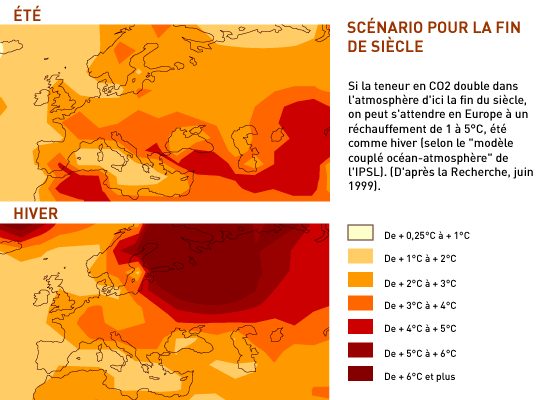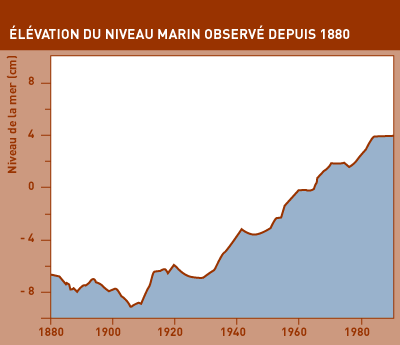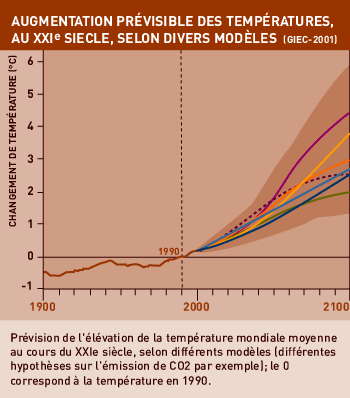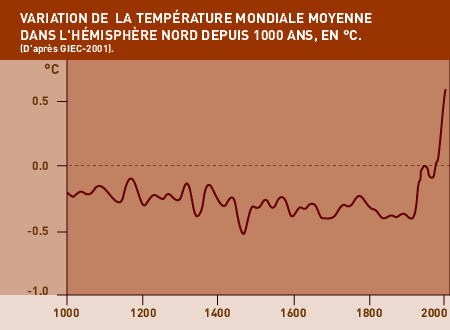Polar Encyclopædia
THE IMPACT OF GLOBAL WARMING

THE ARCTIC: IN THE FRONT LINE OF CLIMATE CHANGE
The evidence of global warming in irrefutable. In the course of the 20th century, the average temperature at the Earth’s surface rose by 0.6°C, but it went up between 3°C and 4°C in just 60 years in the NW of Canada and in Alaska. The Arctic is the region most affected by the phenomenon of increased absorption of the sun’s heat. When the snow or ice cover on land or ocean disappears, the Earth’s surface loses its white reflective layer (the albedo effect) and instead of bouncing off, the sunlight heats it up even more.
Furthermore, currents of warmer water from the Atlantic have now been detected at great depths in the Arctic Basin.

THE ICE PACK WILL BE GONE WITHIN A CENTURY
Les données satellitaires montrent que la surface de la banquise s’est réduite de 6,5% par dSatellite imagery shows that the area covered by pack ice (the ice sheet on the ocean surface) shrank by 6.5% each decade between 1980 and 2000. At the end of the northern summer in 2005, two oceanographic vessels reached the record latitude of 87°N before they were finally stopped by ice. The thickness of the sea ice is diminishing too: observations made over the period 1993-1997 show that the average ice thickness was 1.5 m less than shown by measurements over the period 1958-1976.
All the forecasts tend to agree: there will be no more sea ice during the northern summer by the middle of this century.

THE PERMAFROST IS MELTING
All the villages and other infrastructure such as mining facilities within the Arctic Circle were originally built on hard ground that was frozen all year round. But in summer this permafrost is now melting to a significant depth and buildings are beginning to lean and sag. There is also a growing risk that oil pipelines will rupture and leak. Trees in the boreal forests are starting to fall over because their shallow root systems no longer hold in the muddy ground. In addition, decomposition in the marshy ground is releasing large quantities of methane gas and this is aggravating the greenhouse effect.

THE IMPACT ON THE LIFE OF NATIVE PEOPLES
The native inhabitants of the polar zones are also hard hit by global warming. The sea is now freezing over later and the sea ice is melting earlier, which shortens the period during which the people can hunt and travel on the ice pack. And as less of the ground freezes, the coast becomes subject to erosion and this damages the habitat and undermines roads.
AN ECOSYSTEM UNDER THREAT
Down through the millennia, the fauna living in polar regions have adapted biologically to their frontier existence, but their frontier is now threatened. More and more species from further south (birds, red foxes, brown bears, insects, fish…) are migrating further north now that the climate is less rigorous. And they are now competing for food and territory with the endemic species, which are also threatened by the numerous parasites and microbes that the new arrivals bring with them.
The polar bear uses the sea ice as a platform from which to hunt his staple food, the seal. If the pack ice disappears, the polar bear will disappear with it.
Another ecological threat is the inevitable intensification of economic activity (such as oil and gas exploration and production) once the sea ice melts and the Arctic seaways become accessible.
TO FIND OUT MORE …
USEFUL WEB SITE
http://www.cnrs.fr/dossiers/dosclim/
http://www.wmo.ch/
http://www.ademe.fr
http://www.ipcc.ch/
Support the project with a donation
The Polar POD expedition is one of the stamp of the pioners, a human adventure coupled with a technological challenge, an oceanographic exploration never before carried out which will mark a milestone in the discovery of the oceans.
Thank you for your support !